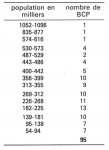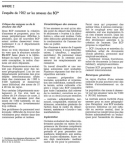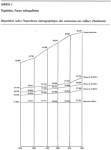À propos des normes du groupe de travail sur lesBCP
- Auteur : Yvert, Louis
- Résumé en anglais : In 1982, a working party has prepared a standards project about the resources of the central lending libraries in personnel, vehicles and collections, according to the public involved. That project had not been published yet. In this article, the author did not only stick to a strict review of the group's work, but attempted to point out the problems faced while establishing such standards, as well as the reasons pleading for their publication, such as : the direct application of the devolution measures stated in 1982 and 1983 to the public libraries in 1986; a necessary and clear statement about the costs of a normal running of the services. It is obviously impossible to set up standards of resources without having a clear view of the missions to be carried out. In a first part, the development of the missions of the central lending libraries is outlined : what documents, for what kind of public, and how... Then the author introduces the various development policies which have been elaborated by the central government since 1967. The figures of these policies - some of them unpublished - were the first normative access to the means to be used as well as the quantitative programm of the buildings which development between 1945 and 1980 is studied too. After introduction of the work, some notes are made about the proposed standards : distribution of the resources between the central and the branch libraries, comparison with the municipal libraries standards and with various studies on central lending libraries, costs of running... Following the article, a survey of : - how regional centers have been established in 1945, together with the central lending libraries, and abolished one year later. - the results of the enquiry held in 1982 on the branches of the central lending libraries.
- Résumé : En 1982, un groupe de travail a élaboré un projet de normes concernant les moyens des bibliothèques centrales de prêt en personnel, véhicules et collections en fonction de la population à desservir, projet qui n'avait pas encore été publié. Dans le présent article, l'auteur ne s'est pas limité au strict compte rendu des travaux du groupe, mais s'est efforcé de préciser les difficultés rencontrées dans l'établissement de telles normes et les raisons qui plaident en faveur de leur publication, notamment l'application aux bibliothèques publiques, en 1986, des mesures de décentralisation décidées en 1982 et 1983 et la nécessaire clarification concernant les coûts de fonctionnement normal des services. Il est naturellement impossible de fixer des normes en moyens sans avoir une idée aussi claire que possible des missions à remplir. L'importante évolution des missions des BCP depuis leur création en 1945 est donc esquissée au préalable : quels documents, pour quel public et de quelle façon ? Les différents plans de développement des BCP élaborés depuis 1967 par l'administration centrale sont ensuite présentés. Ces plans chiffrés, dont certains non encore publiés, ont en effet constitué pendant longtemps une première approche normative des moyens à mettre en oeuvre, de même que la programmation quantitative des bâtiments dont l'évolution de 1945 à 1980 est également étudiée. Après la présentation des travaux du groupe, des remarques sont faites sur les normes proposées : répartition des moyens entre centrale et annexes, comparaison avec les normes relatives aux bibliothèques municipales et avec diverses études consacrées aux BCP, coût de fonctionnement. A la suite de l'article sont exposés : - les conditions dans lesquelles des centres régionaux ont été créés en 1945 parallèlement aux BCP et supprimés l'année suivante ; - les résultats de l'enquête réalisée en 1982 sur les annexes des BCP.
- Paru dans le numéro : n°3-4 : BCP
- Licence de diffusion : Tous droits réservés
- Format : Fichier XML
- Étendue : 104552
- Date de publication : 1985
- Langue : fr
- Sujet(s) : bibliothèque centrale de prêt , norme , projet
- Type de ressource : Text
Ce document est également disponible dans le format suivant :
Document faisant partie de cette ressource :

















